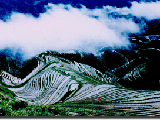 Unexpected cold weather has turned Mount Longji, a popular terraced landscape in northern Guangxi Zhuang Autonomous Region known as "the back of the dragon", into a world of snowy splendor.
Unexpected cold weather has turned Mount Longji, a popular terraced landscape in northern Guangxi Zhuang Autonomous Region known as "the back of the dragon", into a world of snowy splendor.
Many visitors, such as Andrew Lockwood from New Zealand, were excited by the snow.
"Terraced fields, white snow and huts spread in the mountains have formed a picture of sheer beauty," said Lockwood, who added it was all sunshine now at the pastures back in his home country.
Pan Lianfeng, a 34-year-old woman farmer and part-time tour guide from Huangluo Village, 103 km away from the scenic city of Guilin, also wasted no time in climbing to the top of the mountain to view the scenery after the snow.
"Amidst thin fog, layers of terraced fields, covered with white snow, extend afar just like the scales of a dragon," said Pan, of the ethnic Yao group.
The mountain got its name among local residents because the Longji mountain range looks like the back of a dragon, China's legendary icon. But it seldom snows on Mount Longji in winter.
The terraced fields, built by local farmers of different ethnic groups from the Yuan Dynasty (1271-1368) to Qing Dynasty (1644-1911), spread 500 meters from the foot of Mount Longji to the mountaintop. The spectacular landscape has made it a popular scenic site.
Pan comes from the "red Yaos", a special tribe of the ethnic Yao group who distinguish themselves by sporting red clothes as their traditional costumes. Women of the red Yao group take pride in growing long hair and being good at embroidery.
"Several years back, when we first saw foreign tourists, we were shy and dared not take photos with them," Pan recalled. "But as tourism booms, we have met more foreigners, and our way of thinking is more open and we are now more at ease when doing business."
Pan employs herself as a tour guide during the slack-farming season.
"The scenery at Mount Longji changes with the seasons. You can see the moon from the water in the terraced fields at the sowing period in spring, green crops in summer, golden rice in autumn, and the 'white dragon' in a rare cold winter," she said.
Pan said the unexpected snow this year has helped attract more tourists to Longji.
The tourism business has made Pan's family prosperous and she has bought a new motorcycle, so the family members no longer have to climb the mountains on foot.
Huangluo, Pan's village, falls under the jurisdiction of the Multiethnic Autonomous County of Longsheng, home to 160,000 people of ethnic groups including the Zhuang, Dong, Yao and Miao.
Tourism has become a new way for more and more local residents to make extra money. Residents of the Zhuang ethnic group at Ping'an Village live on half of Mount Longji and make a fortune by operating over 70 family hotels.
After the snow this winter, Liao Fengji, a Zhuang woman of 40, had to go to the parking ground to win over more customers for her home hotel. She took the initiative to offer her house as a hotel whenever a bus stopped.
Liao Daohe, another farmer of the Zhuang ethnic group, operates the only western-style bar at the mountain. Liao's bar, actually a raised wooden hut, is popular among foreign tourists as it offers drinks such as whisky and hot coffee and the menu is in English.
From Christmas through New Year's Day, Liao's bar was always packed with visitors.
"I always get ideas faster than others. Doing business requires wisdom," said Liao, explaining the reason behind his business success.
Up to now, more than 4,000 farmers in Longsheng county are engaged in tourist services while also doing farming.
Last year, 150,000 tourists visited Mount Longji alone. And 2,000 poor farmers in the area have been lifted out of poverty because of the tourism industry, said a local official.
With improvement in living standards, residents of ethnic groups in Longsheng also strive hard to keep the distinctive traditions of their respective ethnic groups.
On reaching home for a New Year's holiday, the first thing Pan Hongkui of the red Yaos, a 19-year-old student with a normal school in Longsheng, did was to learn and practice the skills for making embroidery from her elder sister-in-law.
"Though we young people will someday go to the outside world, the traditional culture of the red Yao ethnic group is a precious heritage and we should try our best to carry on the traditional culture despite changes in living conditions," said Pan.
(Xinhua News Agency January 6, 2003)
|

